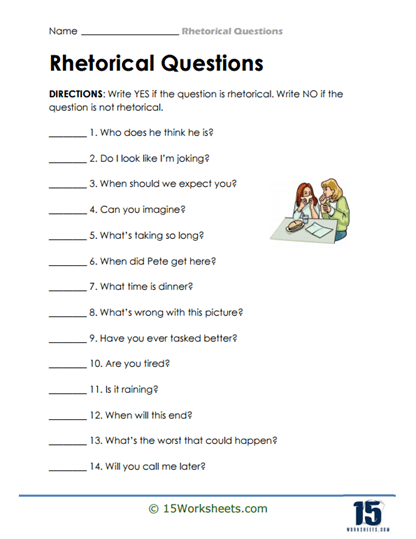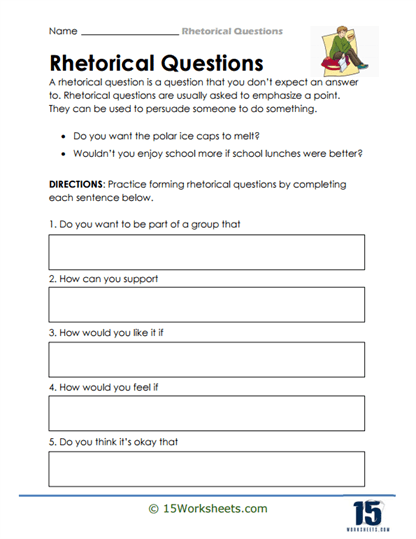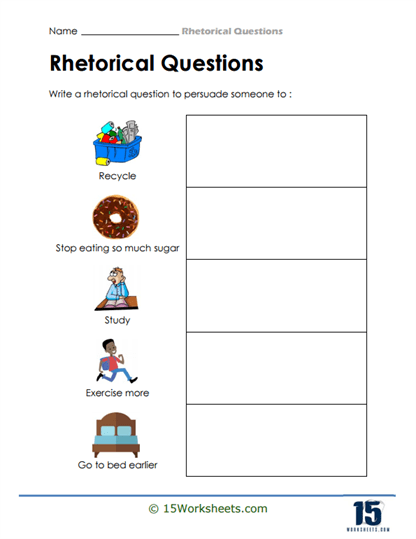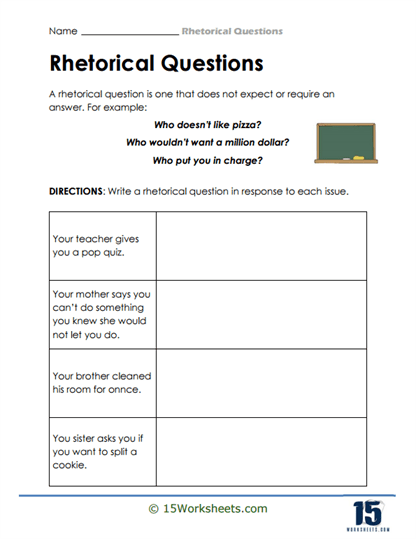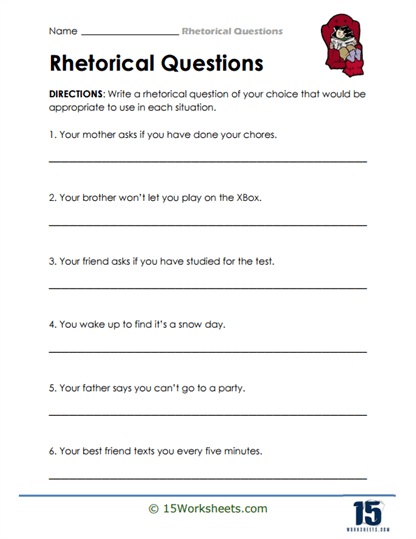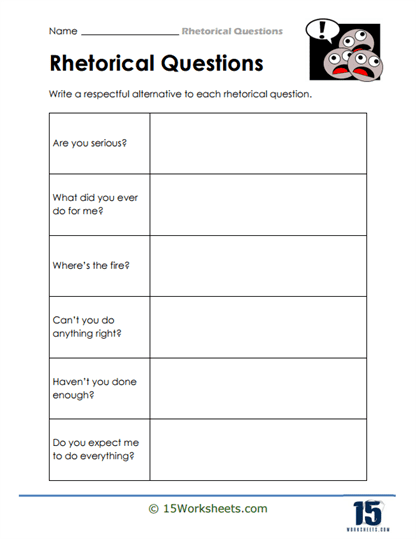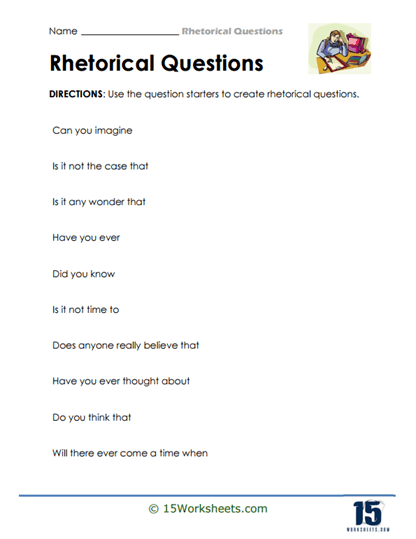Rhetorical Questions Worksheets
About These 15 Worksheets
The worksheet collection offers an engaging activities designed to help students master the concept and usage of rhetorical questions. These worksheets are an excellent resource for teachers, students, and homeschoolers, aiming to improve language skills by introducing and reinforcing the purpose and effectiveness of rhetorical questions in communication. Each worksheet is thoughtfully crafted to guide students through identifying, creating, and analyzing rhetorical questions, making it easier for them to understand how these questions can be used to emphasize a point or provoke thought without expecting a direct answer.
One of the worksheets in this collection prompts students to match sentences with appropriate rhetorical question tags, helping them see how rhetorical questions can subtly alter the tone of a statement or make it more engaging. By completing sentences with tags such as “don’t you?” or “right?”, students learn to create rhetorical questions that can turn a straightforward statement into a persuasive or emphatic remark. This exercise not only enhances their understanding of rhetorical questions but also improves their ability to use them effectively in writing and conversation.
Another worksheet challenges students to choose the correct rhetorical question from a list to respond in the affirmative, helping them to recognize and differentiate rhetorical questions from other types of questions. This type of activity is particularly useful for developing critical thinking skills, as students must consider the context and implied meaning behind each question. By understanding the subtleties of rhetorical questions, students can better appreciate how these questions are used in everyday language to express ideas, convey emotions, or persuade an audience.
The set includes worksheets that require students to create their own rhetorical questions in response to given scenarios. This activity encourages creativity and deeper engagement with the concept, as students must think critically about how to frame a question that emphasizes a point or evokes an emotional response. By practicing the creation of rhetorical questions, students gain confidence in their ability to use this powerful rhetorical device in their own writing and speech.
Some worksheets in the collection focus on identifying whether a question is rhetorical or not. Students are presented with a series of questions and are asked to determine if each one is rhetorical. This exercise reinforces the definition and purpose of rhetorical questions, ensuring that students can recognize them in various contexts. Additionally, this activity helps students develop a more nuanced understanding of language, as they learn to distinguish between questions that seek information and those that are intended to make a point.
The collection also includes activities that highlight the importance of tone and respectfulness in using rhetorical questions. For instance, one worksheet asks students to identify whether each rhetorical question is respectful or not. This task teaches students that while rhetorical questions can be an effective tool in communication, they must be used thoughtfully to avoid sounding sarcastic or rude. Understanding the impact of tone is crucial for students as they learn to navigate complex social interactions and express themselves clearly and respectfully.
In addition to these core activities, the collection also includes other types of exercises that reinforce the lessons learned. For example, students could be asked to analyze famous speeches or literary excerpts to identify rhetorical questions and discuss their effect on the audience. Another possible activity could involve group discussions where students pose rhetorical questions to each other, practicing their delivery and exploring how these questions can lead to deeper conversations.
Worksheets that integrate rhetorical questions with other language arts skills, such as persuasive writing or debate, further enhance the collection. By combining the study of rhetorical questions with broader communication strategies, students would gain a more comprehensive understanding of how to use language effectively in various contexts. This holistic approach ensures that students not only learn the mechanics of rhetorical questions but also understand their broader application in both written and spoken communication.
The worksheets are available in PDF format, making them easy to view, download, and print. This format ensures that teachers, students, and homeschoolers have convenient access to the materials, whether for classroom use, homework assignments, or independent study. The clear layout and engaging content of these worksheets make them an ideal resource for teaching rhetorical questions, providing both structure and flexibility to meet the needs of diverse learners.
By working through these carefully designed activities, students will gain a solid foundation in the use and recognition of rhetorical questions, empowering them to communicate more effectively and persuasively. Whether used as part of a larger language arts curriculum or as a focused study on rhetorical techniques, these worksheets offer a comprehensive and engaging way to explore the power of questions that don’t require an answer.
What Are Rhetorical Questions?
Rhetorical questions are questions posed by a speaker or writer that are not intended to require a response. Instead, they are used to make a point, provoke thought, or emphasize a particular idea. Unlike standard questions, which seek information or clarification, rhetorical questions often serve as a persuasive device or a means of highlighting the obvious. For example, the question “Isn’t it a bit late to start studying now?” is not meant to be answered; rather, it is intended to suggest that starting to study at the last minute is not wise.
The primary purpose of rhetorical questions is to engage the audience and encourage them to consider the topic at hand more deeply. By posing a rhetorical question, a speaker or writer invites the listener or reader to reflect on the issue, often leading them to the same conclusion the speaker has already reached. This technique is especially effective in persuasive writing and speeches, where the goal is to influence the audience’s thoughts or actions. Rhetorical questions can also serve to highlight the absurdity of a situation, as in the case of “Do pigs fly?”, which underscores the impossibility of the scenario being discussed.
Rhetorical questions are also powerful tools for emphasizing key points. By asking a question that implies its own answer, the speaker can underline the importance of an idea or argument. For example, “How could anyone believe that?” suggests disbelief and invites the audience to share in that incredulity. This technique is often used in arguments to reinforce the speaker’s position and to lead the audience to agree with their perspective. The implied answer in a rhetorical question often aligns with the speaker’s viewpoint, making it a subtle yet effective way to persuade.
Another important function of rhetorical questions is to engage the audience on an emotional level. By asking a question that resonates with the audience’s experiences or feelings, the speaker can create a connection that draws the audience in. For instance, “Don’t we all want to live in a safer world?” appeals to a common desire, making the audience more receptive to the speaker’s message. This emotional engagement can be a powerful way to build rapport and ensure that the audience is not just listening but also emotionally invested in the topic.







